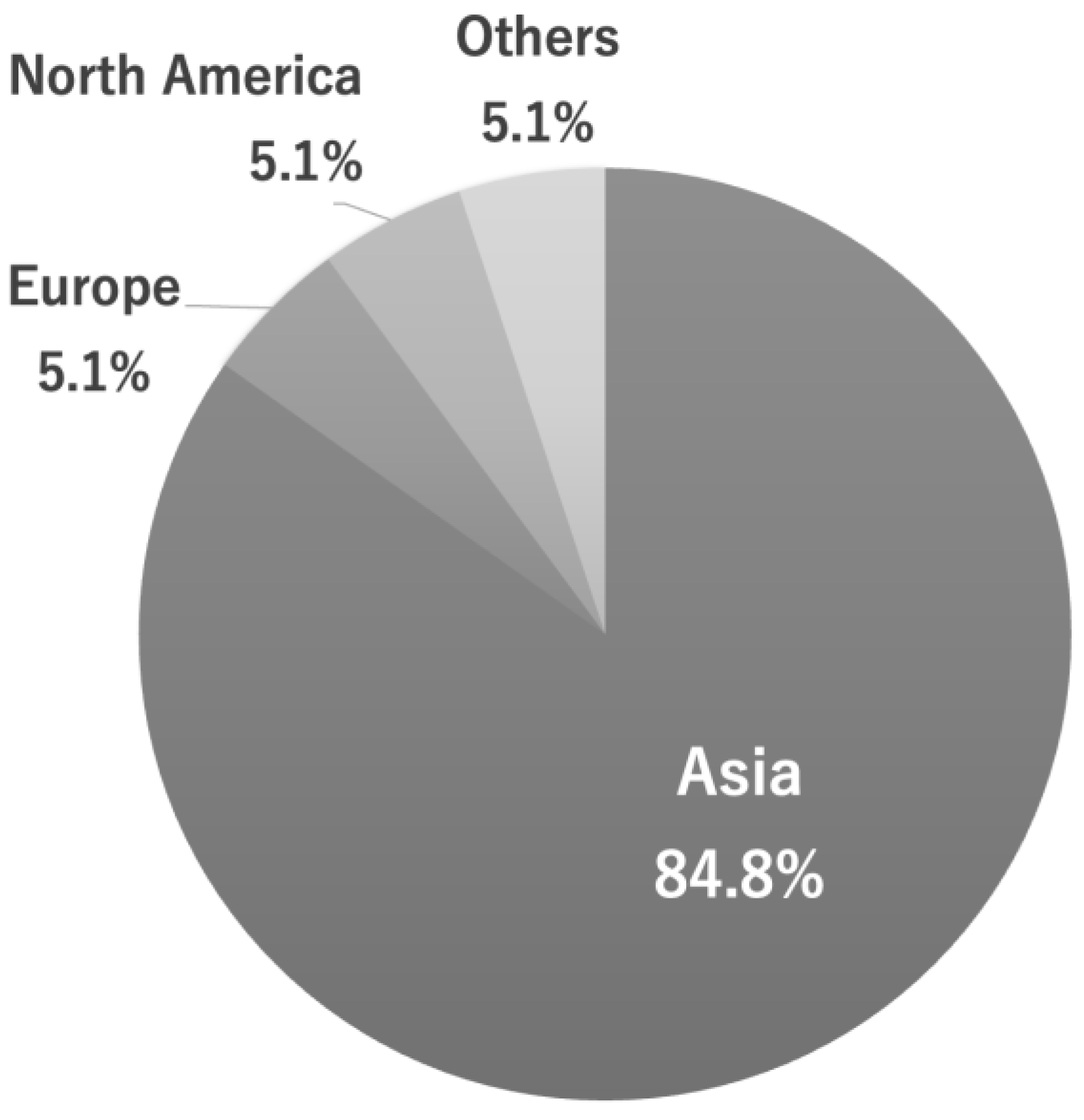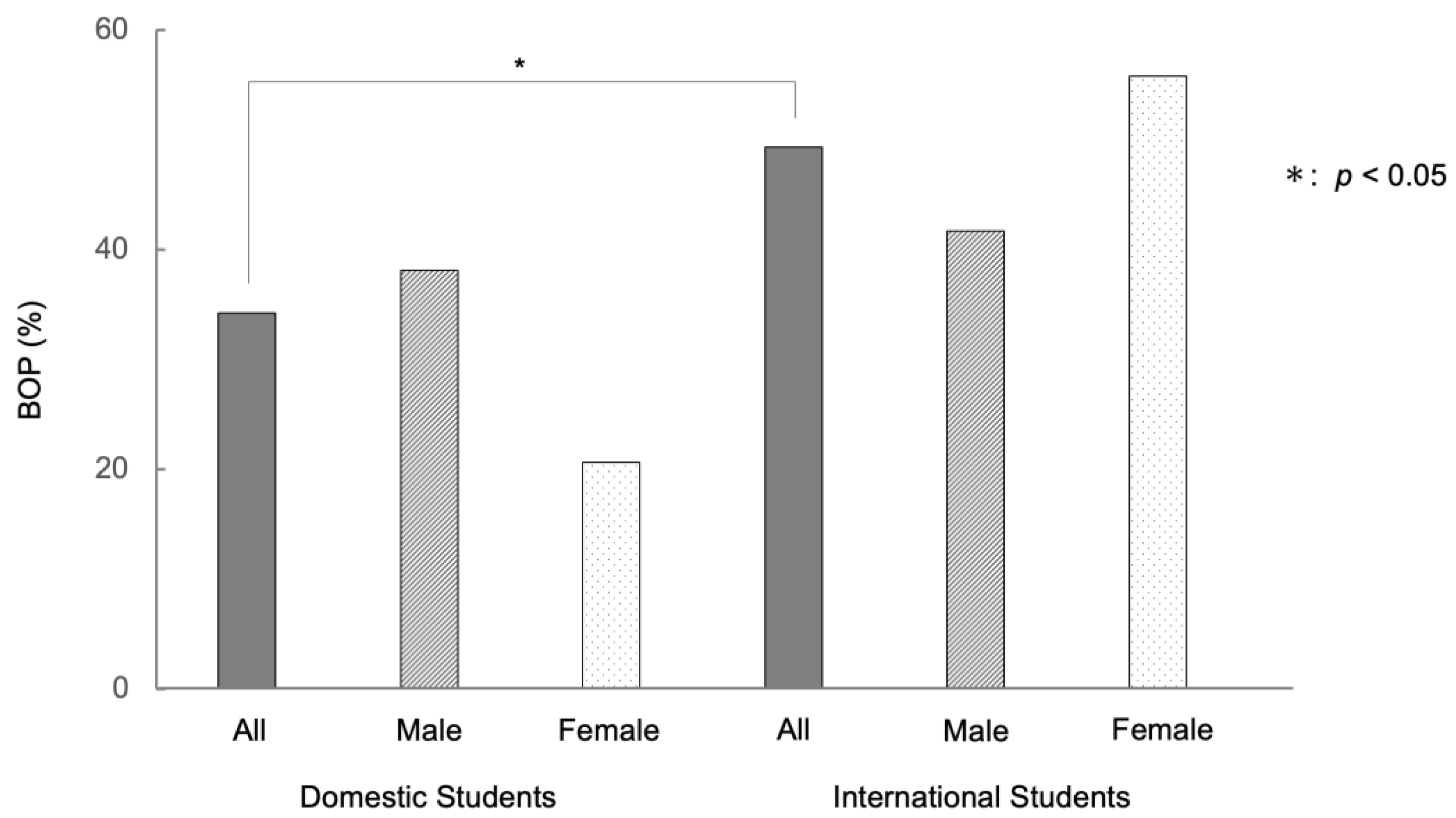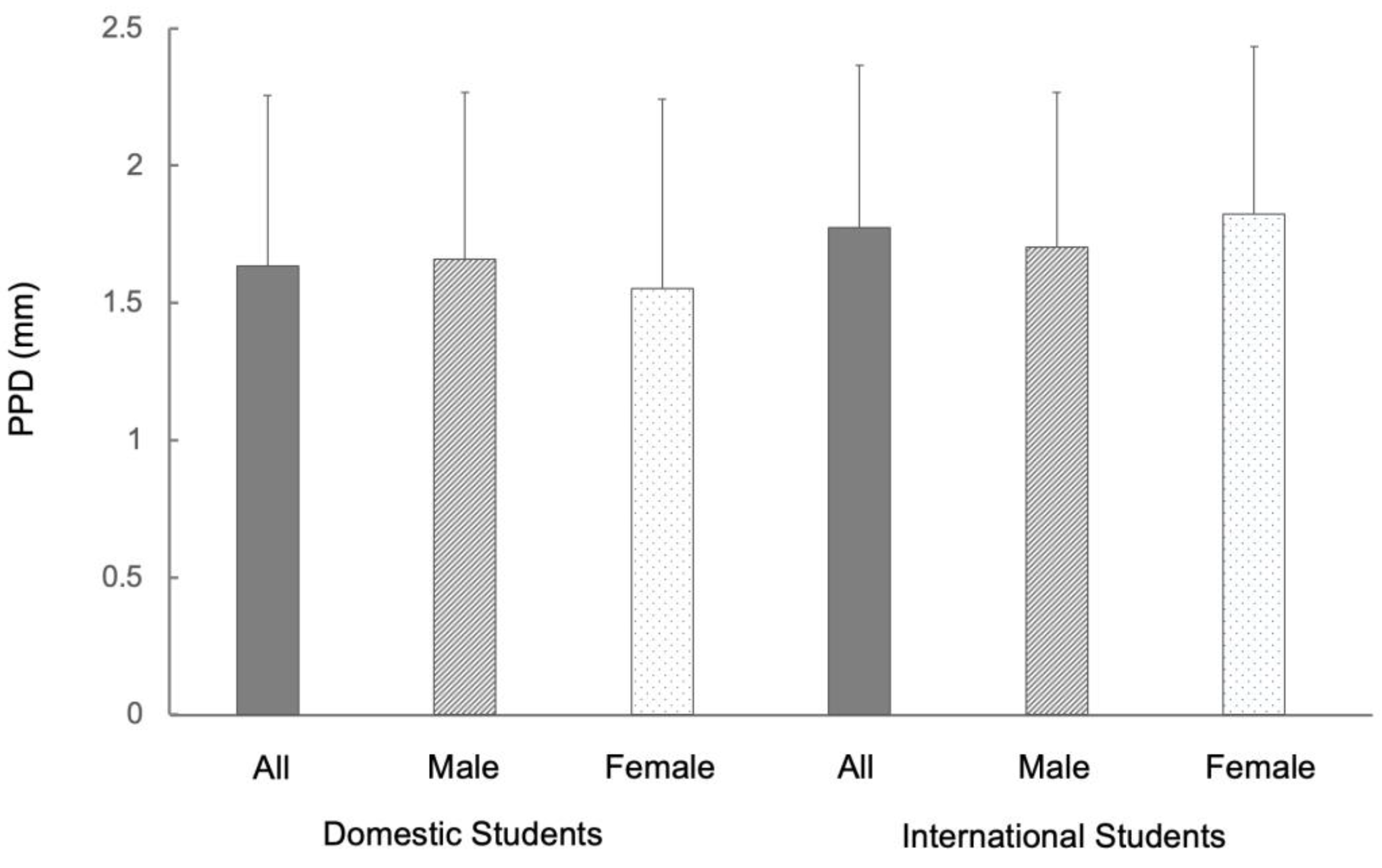A Comparative Study of Periodontal Health Status between International and Domestic University Students in Japan
Abstract
1. Introduction
2. Methods
2.1. Study Design and Population
2.2. Statistical Analyses
3. Results
3.1. Region of Origin of International University Students
3.2. Difference in Bleeding on Probing (BOP) between International and Domestic University Students in Japan
3.3. Differences in Calculus Deposition between International and Domestic University Students
3.4. Difference in Probing Pocket Depth (PPD) Status between International and Domestic University Students
3.5. The Association between BOP and PPD in International and Domestic University Students
4. Discussion
5. Conclusions
Supplementary Materials
Author Contributions
Funding
Institutional Review Board Statement
Informed Consent Statement
Data Availability Statement
Acknowledgments
Conflicts of Interest
References
- Abe, M.; Mitani, A.; Hoshi, K.; Yanagimoto, S. Large Gender Gap of Oral Hygiene Behavior and Its Impact on Gingival Health in Late Adolescence. Int. J. Environ. Res. Public Health 2020, 17, 4394. [Google Scholar] [CrossRef]
- Abe, M.; Mitani, A.; Yao, A.; Zong, L.; Zhang, C.D.; Hoshi, K.; Yanagimoto, S. Oral Health in Japan: State-of-the-Art and Perspectives. Int. J. Environ. Res. Public Health 2022, 19, 8232. [Google Scholar] [CrossRef]
- Pihlstrom, B.L.; Michalowicz, B.S.; Johnson, N.W. Periodontal diseases. Lancet 2005, 366, 1809–1820. [Google Scholar] [CrossRef]
- Marcenes, W.; Kassebaum, N.J.; Bernabe, E.; Flaxman, A.; Naghavi, M.; Lopez, A.; Murray, C.J. Global burden of oral conditions in 1990–2010: A systematic analysis. J. Dent. Res. 2013, 92, 592–597. [Google Scholar] [CrossRef]
- Aida, J.; Ando, Y.; Akhter, R.; Aoyama, H.; Masui, M.; Morita, M. Reasons for permanent tooth extractions in Japan. J. Epidemiol. 2006, 16, 214–219. [Google Scholar] [CrossRef]
- Morita, M.; Kimura, T.; Kanegae, M.; Ishikawa, A.; Watanabe, T. Reasons for extraction of permanent teeth in Japan. Community Dent. Oral Epidemiol. 1994, 22 Pt 1, 303–306. [Google Scholar] [CrossRef]
- Suzuki, S.; Sugihara, N.; Kamijo, H.; Morita, M.; Kawato, T.; Tsuneishi, M.; Kobayashi, K.; Hasuike, Y.; Sato, T. Reasons for Tooth Extractions in Japan: The Second Nationwide Survey. Int. Dent. J. 2022, 72, 366–372. [Google Scholar] [CrossRef]
- Nazir, M.A. Prevalence of periodontal disease, its association with systemic diseases and prevention. Int. J. Health Sci. 2017, 11, 72–80. [Google Scholar]
- Moraschini, V.; Calasans-Maia, J.A.; Calasans-Maia, M.D. Association between asthma and periodontal disease: A systematic review and meta-analysis. J. Periodontol. 2018, 89, 440–455. [Google Scholar] [CrossRef]
- Dong, J.; Li, W.; Wang, Q.; Chen, J.; Zu, Y.; Zhou, X.; Guo, Q. Relationships Between Oral Microecosystem and Respiratory Diseases. Front. Mol. Biosci. 2021, 8, 718222. [Google Scholar] [CrossRef]
- Moreillon, P.; Que, Y.A. Infective endocarditis. Lancet 2004, 363, 139–149. [Google Scholar] [CrossRef]
- Byun, S.H.; Lee, S.; Kang, S.H.; Choi, H.G.; Hong, S.J. Cross-Sectional Analysis of the Association between Periodontitis and Cardiovascular Disease Using the Korean Genome and Epidemiology Study Data. Int. J. Environ. Res. Public Health 2020, 17, 5237. [Google Scholar] [CrossRef]
- Hansen, P.R.; Holmstrup, P. Cardiovascular Diseases and Periodontitis. Adv. Exp. Med. Biol. 2022, 1373, 261–280. [Google Scholar]
- Kaur, S.; White, S.; Bartold, P.M. Periodontal disease and rheumatoid arthritis: A systematic review. J. Dent. Res. 2013, 92, 399–408. [Google Scholar] [CrossRef]
- Borgnakke, W.S.; Ylostalo, P.V.; Taylor, G.W.; Genco, R.J. Effect of periodontal disease on diabetes: Systematic review of epidemiologic observational evidence. J. Clin. Periodontol. 2013, 40 (Suppl. S14), S135–S152. [Google Scholar] [CrossRef]
- Abe, M.; Mori, Y.; Inaki, R.; Ohata, Y.; Abe, T.; Saijo, H.; Ohkubo, K.; Hoshi, K.; Takato, T. A Case of Odontogenic Infection by Streptococcus constellatus Leading to Systemic Infection in a Cogan’s Syndrome Patient. Case Rep. Dent. 2014, 2014, 793174. [Google Scholar]
- Abe, M.; Mori, Y.; Saijo, H.; Hoshi, K.; Ohkubo, K.; Ono, T.; Takato, T. The efficacy of dental therapy for an adult case of Henoch-Schönlein Purpura. Oral Sci. Int. 2012, 9, 59–62. [Google Scholar] [CrossRef]
- Inagaki, Y.; Abe, M.; Inaki, R.; Zong, L.; Suenaga, H.; Abe, T.; Hoshi, K. A Case of Systemic Infection Caused by Streptococcus pyogenes Oral Infection in an Edentulous Patient. Diseases 2017, 5, 17. [Google Scholar] [CrossRef]
- Inaki, R.; Igarashi, M.; Abe, M.; Saijo, H.; Hoshi, K.; Takato, T. A case of infective endocarditis by Streptococcus mutans bacteremia induced by asymptomatic chronic dental caries in a wisdom tooth. Oral Sci. Jpn. 2014, 9, 95–96. [Google Scholar]
- Dental Health Division of Health Policy Bureau Ministry of Health, L. a. W., Japan. Report on the Survey of Dental Diseases 2016; Ministry of Health, Labour and Welare: Tokyo, Japan, 2016. (In Japanese)
- Abe, M.; Mitani, A.; Yao, A.; Takeshima, H.; Zong, L.; Hoshi, K.; Yanagimoto, S. Close Associations of Gum Bleeding with Systemic Diseases in Late Adolescence. Int. J. Environ. Res. Public Health 2020, 17, 4290. [Google Scholar] [CrossRef]
- Abe, M.; Mitani, A.; Zong, L.; Hoshi, K.; Yanagimoto, S. The Challenge of Early Prevention of Periodontal Diseases in Japan. J. Adv. Oral Res. 2021, 13, 5–6. [Google Scholar] [CrossRef]
- Ohsato, A.; Abe, M.; Ohkubo, K.; Yoshimasu, H.; Zong, L.; Hoshi, K.; Takato, T.; Yanagimoto, S.; Yamamoto, K. A Comparative Study of Oral Health Status between International and Japanese University Student Patients in Japan. Healthcare 2018, 6, 52. [Google Scholar] [CrossRef]
- World Health Organization. World Health Organization Oral Health Surveys: Basic Methods, 5th ed.; World Health Organization: Geneva, Switzerland, 2013. [Google Scholar]
- Peres, M.A.; Macpherson, L.M.D.; Weyant, R.J.; Daly, B.; Venturelli, R.; Mathur, M.R.; Listl, S.; Celeste, R.K.; Guarnizo-Herreno, C.C.; Kearns, C.; et al. Oral diseases: A global public health challenge. Lancet 2019, 394, 249–260. [Google Scholar] [CrossRef]
- Patel, J.; Wallace, J.; Doshi, M.; Gadanya, M.; Ben Yahya, I.; Roseman, J.; Srisilapanan, P. Oral health for healthy ageing. Lancet Healthy Longev 2021, 2, e521–e527. [Google Scholar] [CrossRef]
- Winkelmann, J.; Listl, S.; van Ginneken, E.; Vassallo, P.; Benzian, H. Universal health coverage cannot be universal without oral health. Lancet Public Health 2023, 8, e8–e10. [Google Scholar] [CrossRef]
- Watt, R.G.; Daly, B.; Allison, P.; Macpherson, L.M.D.; Venturelli, R.; Listl, S.; Weyant, R.J.; Mathur, M.R.; Guarnizo-Herreno, C.C.; Celeste, R.K.; et al. Ending the neglect of global oral health: Time for radical action. Lancet 2019, 394, 261–272. [Google Scholar] [CrossRef]
- Scannapieco, F.A.; Cantos, A. Oral inflammation and infection, and chronic medical diseases: Implications for the elderly. Periodontology 2016, 72, 153–175. [Google Scholar] [CrossRef] [PubMed]
- Si, Y.; Fan, H.; Song, Y.; Zhou, X.; Zhang, J.; Wang, Z. Association between periodontitis and chronic obstructive pulmonary disease in a Chinese population. J. Periodontol. 2012, 83, 1288–1296. [Google Scholar] [CrossRef]
- D’Aiuto, F.; Gkranias, N.; Bhowruth, D.; Khan, T.; Orlandi, M.; Suvan, J.; Masi, S.; Tsakos, G.; Hurel, S.; Hingorani, A.D.; et al. Systemic effects of periodontitis treatment in patients with type 2 diabetes: A 12 month, single-centre, investigator-masked, randomised trial. Lancet Diabetes Endocrinol. 2018, 6, 954–965. [Google Scholar] [CrossRef]
- Goldenberg, R.L.; Culhane, J.F.; Iams, J.D.; Romero, R. Epidemiology and causes of preterm birth. Lancet 2008, 371, 75–84. [Google Scholar] [CrossRef]
- Dubar, M.; Delatre, V.; Moutier, C.; Sy, K.; Agossa, K. Awareness and practices of general practitioners towards the oral-systemic disease relationship: A regionwide survey in France. J. Eval. Clin. Pract. 2019, 26, 1722–1730. [Google Scholar] [CrossRef]
- Ohshima, M.; Zhu, L.; Yamaguchi, Y.; Kikuchi, M.; Nakajima, I.; Langham, C.S.; Lin, W.; Otsuka, K.; Komiyama, K. Comparison of periodontal health status and oral health behavior between Japanese and Chinese dental students. J. Oral Sci. 2009, 51, 275–281. [Google Scholar] [CrossRef]
- Bawaskar, H.S.; Bawaskar, P.H. Oral diseases: A global public health challenge. Lancet 2020, 395, 185–186. [Google Scholar] [CrossRef]
- Peres, M.A.; Daly, B.; Guarnizo-Herreno, C.C.; Benzian, H.; Watt, R.G. Oral diseases: A global public health challenge—Authors’ reply. Lancet 2020, 395, 186–187. [Google Scholar] [CrossRef]
- Vergnes, J.N.; Mazevet, M. Oral diseases: A global public health challenge. Lancet 2020, 395, 186. [Google Scholar] [CrossRef]
- Abe, M.; Mitani, A.; Zong, L.; Zhang, C.D.; Hoshi, K.; Yanagimoto, S. High frequency and long duration of toothbrushing can potentially reduce the risk of common systemic diseases in late adolescence. Spec. Care Dent. Off. Publ. Am. Assoc. Hosp. Dent. Acad. Dent. Handicap. Am. Soc. Geriatr. Dent. 2022, 42, 317–318. [Google Scholar] [CrossRef]
- Abe, M.; Mitani, A.; Yao, A.; Hoshi, K.; Yanagimoto, S. Systemic Disorders Closely Associated with Malocclusion in Late Adolescence: A Review and Perspective. Int. J. Environ. Res. Public Health 2022, 19, 3401. [Google Scholar] [CrossRef]
- Abe, M.; Mitani, A.; Yao, A.; Zhang, C.D.; Hoshi, K.; Yanagimoto, S. Close Association between Awareness of Teeth-Alignment Disorder and Systemic Disorders in Late Adolescence. Healthcare 2021, 9, 370. [Google Scholar] [CrossRef]
- Abe, M.; Mitani, A.; Yao, A.; Zong, L.; Hoshi, K.; Yanagimoto, S. Awareness of Malocclusion Is Closely Associated with Allergic Rhinitis, Asthma, and Arrhythmia in Late Adolescents. Healthcare 2020, 8, 209. [Google Scholar] [CrossRef]





Disclaimer/Publisher’s Note: The statements, opinions and data contained in all publications are solely those of the individual author(s) and contributor(s) and not of MDPI and/or the editor(s). MDPI and/or the editor(s) disclaim responsibility for any injury to people or property resulting from any ideas, methods, instructions or products referred to in the content. |
© 2023 by the authors. Licensee MDPI, Basel, Switzerland. This article is an open access article distributed under the terms and conditions of the Creative Commons Attribution (CC BY) license (https://creativecommons.org/licenses/by/4.0/).
Share and Cite
Abe, M.; Ohsato, A.; Fujihara, Y.; Hoshi, K.; Yanagimoto, S. A Comparative Study of Periodontal Health Status between International and Domestic University Students in Japan. Int. J. Environ. Res. Public Health 2023, 20, 3866. https://doi.org/10.3390/ijerph20053866
Abe M, Ohsato A, Fujihara Y, Hoshi K, Yanagimoto S. A Comparative Study of Periodontal Health Status between International and Domestic University Students in Japan. International Journal of Environmental Research and Public Health. 2023; 20(5):3866. https://doi.org/10.3390/ijerph20053866
Chicago/Turabian StyleAbe, Masanobu, Ai Ohsato, Yuko Fujihara, Kazuto Hoshi, and Shintaro Yanagimoto. 2023. "A Comparative Study of Periodontal Health Status between International and Domestic University Students in Japan" International Journal of Environmental Research and Public Health 20, no. 5: 3866. https://doi.org/10.3390/ijerph20053866
APA StyleAbe, M., Ohsato, A., Fujihara, Y., Hoshi, K., & Yanagimoto, S. (2023). A Comparative Study of Periodontal Health Status between International and Domestic University Students in Japan. International Journal of Environmental Research and Public Health, 20(5), 3866. https://doi.org/10.3390/ijerph20053866





